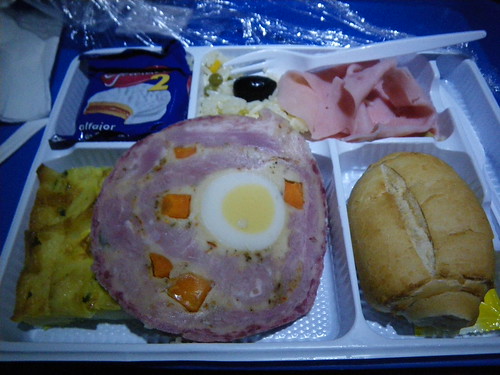Moving north away from Tierra del Fuego took 32 hours, two buses, a ferry (in which we spotted several dolphins playing in the wake), and two border crossings. When we arrived in Puerto Madryn we were beat. With one week of our Latin American journey remaining we got to quick work despite our exhaustion, partnered up with three other travelers, and rented a car for the next few days so that we could enjoy all the ecology of the area.
 With nasty wind coming off the water we decided head south first to the penguin colony at Punta Tombo. Jill and I were still a bit disappointed with our last penguin experience in Tierra del Fuego and since this was a relatively cheap way to get a do-over, we went for it.
With nasty wind coming off the water we decided head south first to the penguin colony at Punta Tombo. Jill and I were still a bit disappointed with our last penguin experience in Tierra del Fuego and since this was a relatively cheap way to get a do-over, we went for it.
After paying the entry fee the guard told us that it would be 1500m to the beach. We figured that wasn’t too long of a walk but as soon as we stepped away from the guard shack we saw our first nesting Magellanic Penguin. Walking along there were literally penguins everywhere, and most shrubs sheltered one or two nests.
November is a special time for the Magellanic Penguins of Patagonia.  This is the time of year that the eggs begin to hatch and the young start to be born. Having just seen a bunch of nesting penguins in Tierra del Fuego we were expecting to see a complete lack of activity once again. It was with a bit of surprise when I turned to my left and saw a mother feeding her little chick.
This is the time of year that the eggs begin to hatch and the young start to be born. Having just seen a bunch of nesting penguins in Tierra del Fuego we were expecting to see a complete lack of activity once again. It was with a bit of surprise when I turned to my left and saw a mother feeding her little chick.
That wouldn’t be the last penguinito we’d see either. As we got further to the beach we found several more little chicks, mostly on account of their nests being in the roped off path. The chicks make a little screeching noise when they want food, and the parent penguins were more than happy to oblige. We knew we’d finally gotten our timing right, when we walked to the beach and saw a bunch of adult penguins played in the surf.
On the way out we passed another nest that was particularly special. This one was just eggs, but one of those eggs was rocking and you could see just a pinprick of a hole in the end facing up. One of the folks we rented the car with is actually a biologist specializing in birds (now that’s some serious luck) and although he professes to not know too much about penguins, he told us that it can often take up to 10 hours for a bird to poke out of its shell. We didn’t have that sort of time, so we decided to leave them with their privacy and continue on our journey.












Recent Comments